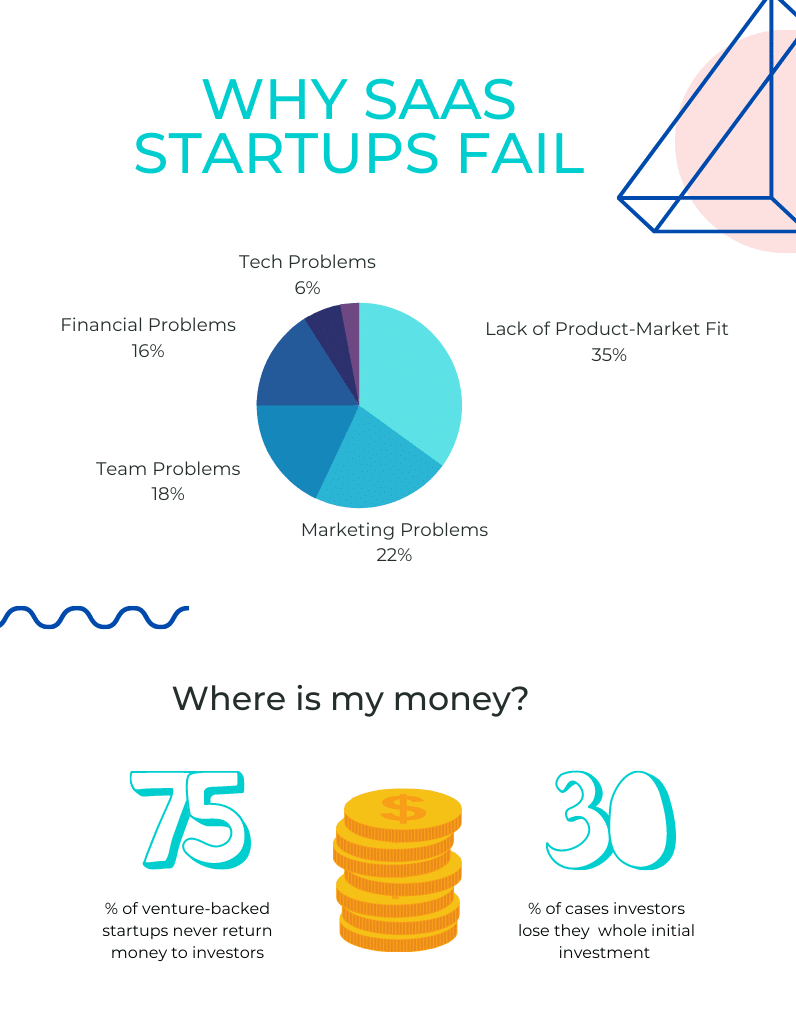4 Reasons Why SaaS Startups Fail
We’ve been operating in the SaaS market for more than 7 years. We helped huge enterprises build their sophisticated software as well as small newborn startups to create their MVPs. During that time, we’ve seen firsthand the challenges that SaaS startups face. One of the most frequently asked questions we receive is, “How many SaaS startups fail in the first year of work?” In our portfolio, more than 30 SaaS startups, 20% of them had failed in the first 3 years, highlighting the risks and challenges associated with launching a new business.
Another commonly asked question is, “What is the business failure rate in the USA?” According to the U.S. Bureau of Labor Statistics (BLS) report, around 20% of new businesses don’t make it past the two-year mark, with 45% closing down before the five-year milestone and 65% calling it quits before hitting the ten-year mark. A mere 25% of new businesses manage to survive for fifteen years or more. These statistics underscore the importance of careful planning, execution, and ongoing support in the early stages of a business.
So, why do SaaS businesses fail, and What kind of challenges do they experience in the first few years? Check out our in-depth article on the challenges that SaaS businesses face in their early years, and get actionable insights on overcoming them.
SaaS Fail #1 Insufficient funds
Adleaf Technologies
Chetan Vashistth first founded Adleaf back in 2013. He intended it to serve as a blend of software solutions and various programming boot camps. Though the business seemed to have a lot of promise at first, poor management and bad financial decision-making eventually ruined Adleaf’s viability.
According to Vashistth, the company was set to operate on a shoestring budget until it had a decent income in place, but partners convinced him to make his business look as shiny and new as possible. Over a few years, this spending spree put the company too deep into the red to ever get out.
Zapsteam
Zapstream was designed in 2015 as a unique new live-streaming platform. It initially raised $1 million in startup cash and almost immediately grew to over 100,000 users. Unfortunately, fundraising eventually died off after a while, and the money that did come in was not properly handled. Many former employees blame the failure on the staff’s high average age, which was nearly 40 years old. Not only did the older crowd behind Zapstream seem to not believe in the product, but the CEO’s valuation expectations were too high for big-time investors.
SaaS Fail #2 Focusing on early adopters
Growth Lab
Growth Lab was started as a marketing tool for Instagram creators. With it, they could review their various growth tactics to measure how their hashtags were performing and how many followers they’d attracted. Unfortunately, Instagram put the kibosh on the platform by severely limiting the “hacks” it used to facilitate growth.
The service was incredibly difficult to use, as if this wasn’t enough. Despite various efforts to teach influencers how to use it and even implement automation on their accounts, all of the paying customers soon dropped off. It now exists as a free service that virtually no one uses.
Watu
Watu was founded as a temporary staffing app for companies located in the UK. The brains behind the operation were all experienced developers and staffing firm members, and the attractive new app soon garnered its first major client. Though there was growth, it was ultimately far too slow. There were mistakes as well. For instance, the application Watu built was not well-suited to the UK market, which ended up being far too small for the service to function as intended.
SaaS Fail #3 No market needs
I Voted Remain, Toby Allen, the project linked to Brexit
The idea of this startup was linked to Brexit. The key KPI for us and for a product “I Voted Remain” was sales. But while Brexit turned out to be pretty distinguished, more and more people decided not to buy a T-shirt with the slogan “I had voted Remain”. And business overall was decelerated rapidly. Over time, there was a miserable turnover and many barriers regarding political situations and government promo.
101 Studios
101 Studios was admittedly a great idea. The company essentially produced video games that taught users various subjects (math, medicine, etc.) as they played. The goal was to create an entire line of games that were fun to play but could also help you increase your knowledge of different topics. While most people loved the idea, they simply weren’t on board for the execution. And while edutainment may still be the wave of the future, nobody seemed interested in what 101 Studios had to sell.
SaaS Fail #4 Not enough experience or a wrong business model
Cuddli
To put it simply: Cuddli was designed as a dating app specifically for geeks. Due to this innovative approach, the app caught on quickly enough, with 100k users after just a few months on the market. However, the lack of large market support and the inability to properly monetize the app led to a shutdown in early 2020. The initial plan was to use Foursquare to partner with restaurants and other businesses that might prove interesting date locations. Though the innovation was there, the experience to capitalize on it was not.
Rent Nest
Rent Nest was an app allowing its users to aggregate and share information about homes and flats on the market. Over several years, the startup got to the point where it earned around $12,000 a month. Unfortunately, the company was spending around $40,000 a month! Even so, the reasoning behind the company’s closure was actually underspending, not overspending. Due to a lack of experience, the founders would never invest enough in a project to get it done right. By bouncing from “leak” to “leak,” they eventually spent more than it would have cost to replace the entire dam.
The Top Reasons for SaaS Startup Failure
Analyzing the data provided by the above defunct companies makes it increasingly clear why some businesses (regardless of how many promises they show) simply can’t generate the revenue needed to survive. Among the top reasons for these budding businesses to call it quits?
- Lack of funding / poor money management
- Bad business model/mismanagement
- Poor marketing / bad press
- Lack of team experience
- Lack of market research / no demand for the product
- Bad market fit as a result of poor market research

How many SaaS startups failed in the last 3 years?
For the last 3 years, more than two dozen venture-supported SaaS startups were forced to close their doors. In most cases, these were companies that had been operating for several years or more rather than just first-year failures. A few of these businesses were first acquired by larger brands before being shut down, but one common thread is present in all of the examples: they all began as startups.
So, what can the SaaS community at large learn from the unfortunate fates of these once-budding businesses? From big bungles like Essential and Quibi to smaller endeavors you may not have heard of, we’ll take a look at the decisions that led to the downfall of these software services. And while the COVID-19 pandemic will certainly absorb a bit of the blame, we’ll see how many of these businesses had cracks in the foundation from the very onset.
SaaS companies that failed last year
1. FretLink (Duration: 7 years)
Reason: Financial difficulties, COVID-19
Fretlink was a French technology company founded in 2015 that provided an online platform connecting shippers with carriers for the transportation of goods. The company aimed to simplify and optimize the logistics industry through its platform and technology solutions.
Unfortunately, in 2021, Fretlink announced that it would be closing down its operations due to financial difficulties. Despite its success in raising significant funding rounds in the past, the company struggled to achieve profitability and faced stiff competition from other logistics companies. The COVID-19 pandemic and its impact on the transportation industry also influenced the company’s decision to close.
2. Indicative (Duration: 8 years)
Reason: Financial difficulties
Indicative was a New York-based software company founded in 2014 that provided a platform for analyzing customer data and generating insights to help businesses improve their operations and customer experiences. The company’s platform integrated various data sources and provided users with visualizations and analytics tools to gain insights into their customers’ behavior and preferences.
In 2022, mParticle, a leader in customer data infrastructure, announced that it had acquired Indicative. While Indicative had faced financial difficulties and ultimately had to close down its operations, the acquisition by mParticle represents an opportunity for its technology and expertise to continue impacting the industry.
3. SafeCheck (Duration: 2 years)
Reason: Mismanagement, economic crisis
SafeCheck was a technology company founded in May 2020 with the goal of empowering individuals to take control of their health and well-being, especially during a time when health concerns were more prevalent than ever.
SafeCheck raised a total of $400K in funding over four rounds, with its latest funding round occurring on January 3, 2023, from a Pre-Seed round with three investors, including John Georgakopoulos and TEDCO. Despite these investments, SafeCheck could not weather the economic crisis of 2023 and was forced to shut down.
How to prevent a startup from failing?
Suppose you’re an entrepreneur or founder looking to avoid following in the footsteps of the owners listed above. In that case, there are a few specific steps you can take to maximize your chances of success.
Become a better entrepreneur
Talk with other business leaders, use the best networking tools, attend workshops, read books, and listen to podcasts. Don’t assume that being good at “one thing” is enough to make you a successful business owner.
Consider a co-founder
Having someone with experience to back you up can be a huge benefit when the going gets rough. Just make sure they have the same values and vision for your product or service.
Do more market research
Preparation is key to ensuring you don’t waste your time or money. Find out if there’s demand for what you have to offer, then find out who’s asking for it and whether or not they’re willing to pay. When in doubt, hire marketing experts to do the research for you.
Be adaptable
The business world is constantly evolving, and startups need to be able to adapt to changes quickly. Stay open to new ideas and feedback, and be willing to pivot your business model if necessary.
Happy customers equal a successful startup
Listen to their feedback, meet their expectations, and improve your product or service. Prioritizing customer satisfaction builds a strong brand and loyal customer base, setting you apart from the competition.









